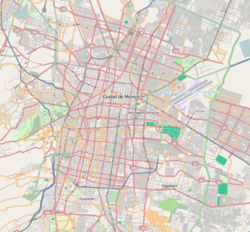Colonia Roma
| Colonia Roma | |
|---|---|
| Neighborhood of Mexico City | |

Replica of Michelangelo's David in Plaza Río de Janeiro, a symbol of Colonia Roma
|
|
|
|
|
| Coordinates: 19°25′07″N 99°09′34″W / 19.418702°N 99.159567°W | |
| City | Mexico City |
| Borough | Cuauhtémoc |
| Population (2010) | |
| • Total | 45,205 |
| By official neighborhood | |
| • Roma Norte | 27,770 |
| • Roma Sur | 17,435 |
Colonia Roma, also called La Roma or simply, Roma, is a district located in the Cuauhtémoc borough of Mexico City just west of the city’s historic center, and in fact is no longer a single colonia (neighborhood) but now two officially defined ones, Roma Norte and Roma Sur, divided by Coahuila street. Currently Roma is known for being the epicenter of hipster subculture in the city, and rivals Polanco as the center of the city's culinary scene. Besides residential buildings, the neighborhood streets are lined with restaurants, bars, clubs, shops, cultural centers, churches and galleries. Many are housed in former French-style mansions dating from the Porfiriato period at the beginning of the 20th century. Roma was designated as a "Barrio Mágico" ("magical neighborhood") by the city in 2011.
The area was a very shallow part of Lake Texcoco, dotted with tiny islands and one small island village of Aztacalco during the pre-Hispanic period. During the colonial period, the area dried up and became rural lands first owned by Hernán Cortés and then by the Counts of Miraville. In the late 19th and early 20th centuries, this area west of what was Mexico City proper was being turned into “modern” colonias for the wealthy seeking to escape the deterioration of city center. The colonia’s height as an “aristocratic” and “European” enclave was from its founding in the 1900s until about the 1940s. However, wealthy residents began to move to newer neighborhoods as early as the 1940s and problems associated with urbanization began to appear in the 1950s. Older mansions began to give way to modern commercial buildings in the 1960s and 1970s as the deterioration became more serious. The 1985 Mexico City earthquake caused widespread destruction in the colonia, especially to newer and more commercial and apartment buildings, even causing one major development to mostly disappear. Since then, there have been efforts to conserve the area’s architectural heritage and regain some of its former prestige with some success.
Roma's borders are:
...
Wikipedia

